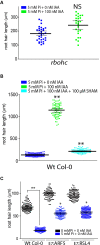High Auxin and High Phosphate Impact on RSL2 Expression and ROS-Homeostasis Linked to Root Hair Growth in Arabidopsis thaliana
- PMID: 30154812
- PMCID: PMC6102359
- DOI: 10.3389/fpls.2018.01164
High Auxin and High Phosphate Impact on RSL2 Expression and ROS-Homeostasis Linked to Root Hair Growth in Arabidopsis thaliana
Abstract
Root hair size determines the surface area/volume ratio of the whole roots exposed to the nutrient and water pools, thereby likely impacting nutrient and water uptake rates. The speed at which they grow is determined both by cell-intrinsic factors like hormones (e.g., auxin) and external environmental signals like nutrient availability in the soil (e.g., phosphate). Overall root hair growth is controlled by the transcription factors RSL4 and RSL2. While high levels of auxin promote root hair growth, high levels of inorganic phosphate (Pi) in the media are able to strongly repress RSL4 and RSL2 expression linked to a decreased polar growth. In this work, we inquired the mechanism used by root hairs to integrate conflicting growth signals like the repressive signal of high Pi levels and a concomitant high auxin exposure that promotes growth and questioned whether these complex signals might activate known molecular players in root hair polar growth. Under these conditions, RSL2 expression (but not RSL4) is activated linked to ROS production and root hair growth. On the other hand, by blocking ROS production derived from the NADPH Oxidase C (or RBOHC for RESPIRATORY BURST OXIDASE HOMOLOG C) and ROS production from Secreted type-III Peroxidases (PERs), it was possible to repress the auxin growth-promoting effect. This study identifies a new layer of complexity between auxin, Pi nutrient availability and RSL2/RSL4 transcription factors all acting on ROS homeostasis and growth at the root hair level.
Keywords: Arabidopsis thaliana; NADPH oxidases; ROS; auxin; peroxidases; phosphate; root hairs.
Figures





Similar articles
-
Molecular link between auxin and ROS-mediated polar growth.Proc Natl Acad Sci U S A. 2017 May 16;114(20):5289-5294. doi: 10.1073/pnas.1701536114. Epub 2017 May 1. Proc Natl Acad Sci U S A. 2017. PMID: 28461488 Free PMC article.
-
RSL4 Takes Control: Multiple Signals, One Transcription Factor.Trends Plant Sci. 2017 Jul;22(7):553-555. doi: 10.1016/j.tplants.2017.04.007. Epub 2017 May 6. Trends Plant Sci. 2017. PMID: 28487046
-
Intensity of a pulse of RSL4 transcription factor synthesis determines Arabidopsis root hair cell size.Nat Plants. 2015 Sep 28;1:15138. doi: 10.1038/nplants.2015.138. Nat Plants. 2015. PMID: 27251390
-
ROS and calcium oscillations are required for polarized root hair growth.Plant Signal Behav. 2022 Dec 31;17(1):2106410. doi: 10.1080/15592324.2022.2106410. Plant Signal Behav. 2022. PMID: 35938584 Free PMC article. Review.
-
Modulatory Role of Reactive Oxygen Species in Root Development in Model Plant of Arabidopsis thaliana.Front Plant Sci. 2020 Sep 16;11:485932. doi: 10.3389/fpls.2020.485932. eCollection 2020. Front Plant Sci. 2020. PMID: 33042167 Free PMC article. Review.
Cited by
-
Impact of Climate Change on the Distributional Potential of the Endemic Species Tamarix dubia Bunge and Conservation Implications for the Irano-Turanian Region.Ecol Evol. 2025 Jul 28;15(8):e71877. doi: 10.1002/ece3.71877. eCollection 2025 Aug. Ecol Evol. 2025. PMID: 40740812 Free PMC article.
-
Default Activation and Nuclear Translocation of the Plant Cellular Energy Sensor SnRK1 Regulate Metabolic Stress Responses and Development.Plant Cell. 2019 Jul;31(7):1614-1632. doi: 10.1105/tpc.18.00500. Epub 2019 May 13. Plant Cell. 2019. PMID: 31123051 Free PMC article.
-
Early transcriptomic changes in cucumber and maize roots in response to FePO4 nanoparticles as a source of P and Fe.Sci Rep. 2025 Apr 6;15(1):11786. doi: 10.1038/s41598-025-95989-6. Sci Rep. 2025. PMID: 40189639 Free PMC article.
-
Genome-wide association study dissects the genetic control of plant height and branch number in response to low-phosphorus stress in Brassica napus.Ann Bot. 2021 Nov 9;128(7):919-930. doi: 10.1093/aob/mcab115. Ann Bot. 2021. PMID: 34490877 Free PMC article.
-
Phosphorus-Use-Efficiency Gene Identification in Fabaceae and RSL2 Expansion in Lupinus albus Is Associated with Low-Phosphorus Adaptation.Genes (Basel). 2024 Aug 9;15(8):1049. doi: 10.3390/genes15081049. Genes (Basel). 2024. PMID: 39202409 Free PMC article.
References
-
- Bustos R., Castrillo G., Linhares F., Puga M. I., Rubio V., Pérez-Pérez J., et al. (2010). A central regulatory system largely controls transcriptional activation and repression responses to phosphate starvation in Arabidopsis. PLoS Genet. 6:e1001102. 10.1371/journal.pgen.1001102 - DOI - PMC - PubMed
LinkOut - more resources
Full Text Sources
Other Literature Sources
Molecular Biology Databases
Research Materials
Miscellaneous

